Exploring Baltic Amber: Origins and Significance
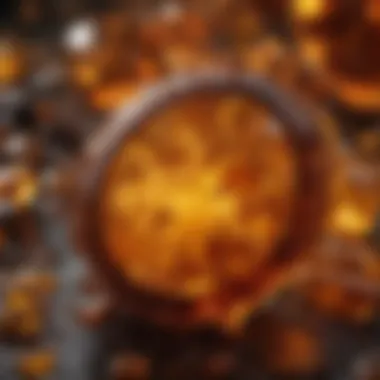
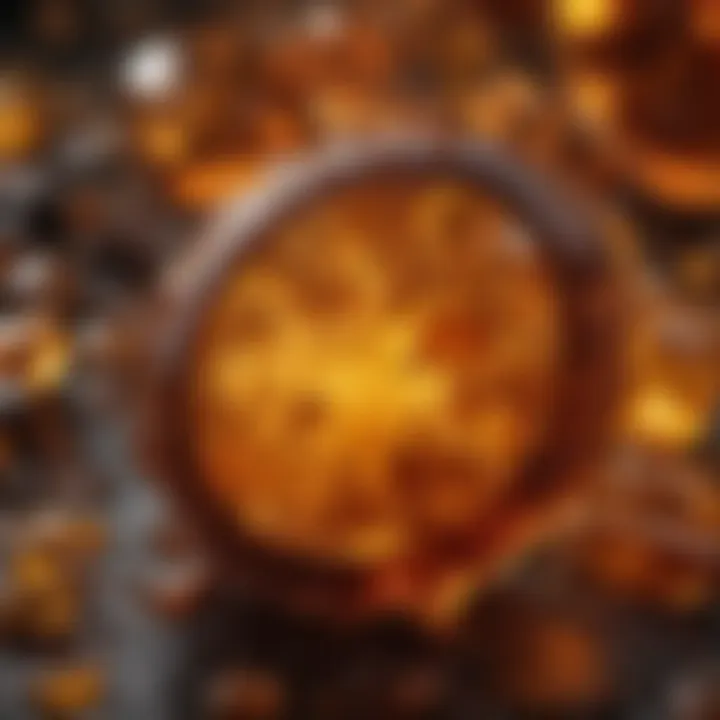
Intro
Baltic amber has fascinated humanity for thousands of years. This beautiful organic gemstone, often found washed up along the coasts of the Baltic Sea, holds stories of ancient forests and sunlit skies. Made from the fossilized resin of trees, its striking colors and warm glow make it a sought-after material for collectors and artisans alike. Yet, amber is not merely a pretty bauble; it is a substance rich in history and cultural significance, weaving through the fabric of numerous societies.
In this article, we will delve into the origins of Baltic amber, explore its unique properties, and uncover its impact on various cultures and economies. By shining a light on both the scientific and socio-cultural aspects of amber, readers will gain a holistic understanding of this captivating material.
Gemstone Overview
Definition of Gemstones
Gemstones are naturally occurring minerals, rocks, or organic materials that people have cut and polished for use in jewelry and decoration. Their intrinsic beauty and rarity often enhance their appeal, transforming them into objects of desire for collectors and enthusiasts alike.
Classification of Gemstones
Gemstones can be classified into two major categories: precious and semi-precious. While traditional definitions assign a high value to diamonds, rubies, sapphires, and emeralds as precious stones, many collectors argue that the distinction is growing thin. Amber, though often categorized as semi-precious, commands significant respect in jewelry-making and holds a special place in cultural and historical contexts.
- Precious gemstones: Diamonds, rubies, sapphires, emeralds
- Semi-precious gemstones: Amber, amethyst, garnet, topaz
Historical Significance
Origins of Gemstone Use
The use of gemstones can be traced back to prehistoric times. Archaeologists have uncovered evidence that our ancestors adorned themselves with simple beads made from naturally found stones. Amber itself was used in jewelry as early as 2000 BCE, particularly in the Baltic region, where it was traded along ancient routes.
"Amber was not merely ornamental but held significant spiritual value. Ancient peoples believed it offered protection and healing."
Cultural Insights: Gemstones in Ancient Civilizations
Throughout history, various civilizations have attributed unique meanings to amber. In ancient Rome, it was believed to bring good luck, while in Greece, it was associated with the sun and warmth. The Vikings valued amber so much that they traded it across distant lands, enhancing its mystique.
In the realm of healing, many traditions regard amber as a powerful element. Practitioners of alternative healing often believe it possesses the ability to absorb negative energy and promote overall wellness. Today, you can still find Baltic amber in teething necklaces for infants, as it is thought to soothe discomfort during this challenging period.
Defining Baltic Amber
Defining Baltic amber is pivotal in grasping its role in both natural history and human culture. As a type of fossilized tree resin, it serves as a bridge between the geological past and the present, linking ancient ecosystems to contemporary uses. Understanding its definitions helps to clarify specific characteristics, applications, and its significance across various domains.
The Geological Makeup
The geological framework that underpins Baltic amber is interesting and layered. This amber is primarily found in the coastal regions of the Baltic Sea, especially within Poland, Lithuania, Latvia, Estonia, and parts of Russia. It largely comes from the species of conifer trees known as Pinus succinifera, which flourished during the Eocene epoch, roughly 44 million years ago. Over the eons, these trees exuded resin that, upon exposure to air and differing environmental conditions, polymerized and solidified, resulting in the amber we recognize today.
The unique environmental circumstances of ancient forests, combined with the right conditions for fossilization, allowed for the development of this remarkable material. Baltic amber deposits can be found not just in pieces but also in larger formations, shaped by the natural tides and coastal processes. Understanding these geological processes provides valuable insight into how amber formed as a solid mass, encapsulating a snapshot of prehistoric life.
Chemical Composition
The heart of amber really lies in its chemical composition, showcasing a blend of organic compounds. The main element of Baltic amber is succinic acid, which contributes not only to its fragrance but also to some of its purported healing properties. Generally, Baltic amber is made up of about 8% to 10% succinic acid, alongside various other organic compounds like terpenes and phenolic compounds.
This unique blend is part of what sets Baltic amber apart from its counterparts. The balance between resin structure and resin age creates the typical yellows, oranges, and browns that define its aesthetic charm. Its lightweight nature and the fact that it can be polished to a brilliant shine make Baltic amber a favorite choice in jewelry and artistic applications. Understanding the chemical underpinnings of amber helps gem enthusiasts appreciate both its beauty and versatility.
Differences from Other Types of Amber
Baltic amber is just one type in a line of several ambers found around the globe. What truly differentiates Baltic amber is its age, geological history, and chemical makeup. For instance, Dominican amber, found in the Caribbean, is often younger and tends to contain a different variety of inclusions. Baltic amber is usually more saturated in color, sometimes exhibiting hues that vary from clear to opaque. While Caribbean counterparts may have a more diverse range of plant and insect inclusions, Baltic amber is prized for the various life forms it encapsulated thousands of years ago.
Sometimes, it's easy to confuse these ambers based on color or surface details, but knowing about their distinct origins and material compositions paints a clearer picture. This information serves aficionados and collectors alike, arming them with the knowledge to discern quality amber gems.
"Baltic amber's clarity and varied hues serve as a testament to its intricate geological and natural history, setting it apart in the vast world of gemstones."
With this understanding under our belts, we can delve deeper into evolutionary processes that shaped this mesmerizing gem and explore its multifaceted role in culture and economy.
Formation and Origins
The creation of Baltic amber is a remarkable story woven into the fabric of ancient ecosystems, where the interplay of climate, environment, and time set the stage for something truly unique. Understanding the formation and origins of Baltic amber is crucial as it sheds light on the long geological processes that contribute to its current status as a sought-after material. Without this context, one may overlook not only the natural beauty and utility of amber but also its profound historical and cultural significance.
The Role of Climate and Environment
Baltic amber originates from the resin of ancient coniferous trees, primarily those in the Pine family. These trees flourished in dense forests during the late Mesozoic era. The climate of this region, characterized by a temperate to subtropical zone, played a pivotal role in the production of amber. The warm temperatures and high humidity allowed the trees to flourish, producing copious amounts of resin.
As the trees aged and weathered, they shed their resin, which pooled in the surrounding environment. This resin, initially sticky and aromatic, served to protect the trees from pests and diseases. However, once the trees died or were felled, the resin was left exposed to the elements. Over time, the resin underwent various chemical changes due to heat, pressure, and environmental conditions, ultimately resulting in the fossilized amber we recognize today.
It’s fascinating to consider how the geographical positioning of the Baltic region, shaped by ancient shifts in landmasses and sea levels, contributed to the conditions necessary for amber formation. In addition, the presence of the ice ages dramatically altered landscapes, exposing and redistributing amber deposits across vast areas. Thus, the interplay of climate and environment carved the path for this stunning natural phenomenon to emerge.
Historical Geological Processes

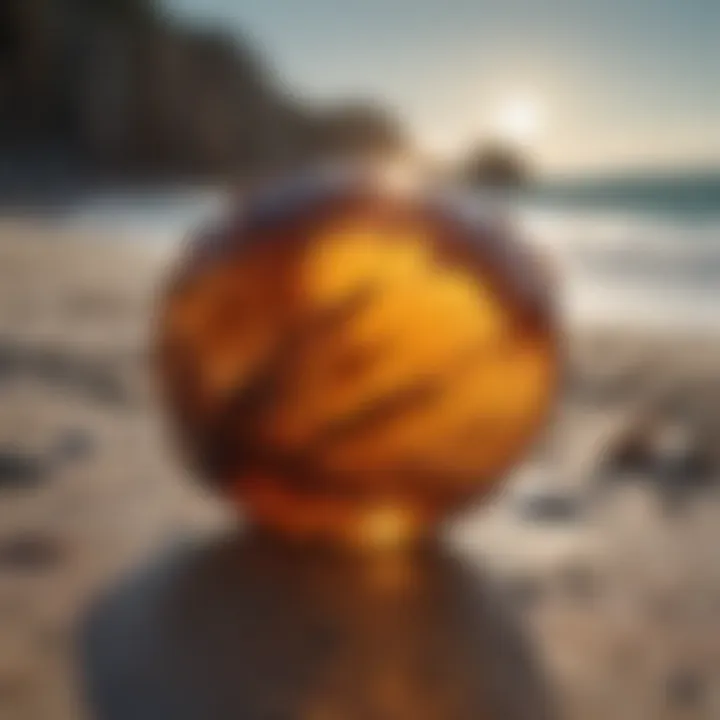
Diving deeper into the geological processes, one can track the sequence of events that led to amber's formation. The journey begins with the trees in the dense forests, but the geological history is a tale of monumental transformations. Various plate tectonic activities pushed the land up and down, creating sedimentation layers that buried the resin over millennia.
As centuries passed, immense pressure from overlying sediments compacted the resin. This process, known as diagenesis, transformed the liquid resin into solid amber. Moreover, chemical processes facilitated the polymerization of the resin, further enhancing amber’s durability and aesthetic qualities. One might say that amber has truly traveled through time, evolving from a protective tree secretion into a prized gemstone.
In essence, the story of Baltic amber is interwoven with the Earth's history – its formation was not merely a singular event but part of continuous geological upheaval, climate change, and biological evolution.
Fossilization and Preservation
A particularly interesting aspect of Baltic amber is its role as a time capsule. Over the centuries, as the resin fossilized, it trapped small organisms, plant material, and even pollen within its transparent embrace. This phenomenon yields insight into the ecosystems of the past, preserving a snapshot of life millions of years ago.
The preservation process, while unique, was not instantaneous. After the resin was deposited, it often had to contend with various environmental factors. Submersion in water, for instance, helped shield the resin from degradation, while layers of sediment provided additional protection against the elements.
When examining Baltic amber, you might encounter inclusions such as tiny insects, leaves, or even air bubbles. These elements not only enhance the beauty of each piece but also provide invaluable information to scientists studying ancient climates, fauna, and flora.
"Amber is not just a gemstone; it's a preserved moment in history, telling tales of life forms that walked the earth long ago."
Today, collectors and enthusiasts treasure these inclusions, viewing them as tiny artifacts frozen in time. Each piece is a reminder of Earth's dynamic history, bridging the gap between the past and our present. As such, understanding the formation and origins of Baltic amber offers a window into the fascinating processes that have shaped not only this remarkable substance but also life on our planet.
Physical Properties of Baltic Amber
Baltic amber possesses a plethora of physical properties that have fascinated collectors, jewelers, and enthusiasts alike over the centuries. Understanding these properties is crucial for appreciating not only the aesthetic value of this prehistoric resin but also its practical applications in various fields. The interplay of its color, hardness, and the unique inclusions within amber makes it a remarkable material that tells a story beyond its surface.
Color Variations and Transparency
Baltic amber showcases a stunning array of color variations ranging from deep honey hues to bright lemon shades, as well as more unique tones like red or even green. The spectrum of colors arises from the conditions during its formation and the organic materials interred in the resin. The transparency of amber can vary significantly, with some pieces appearing almost glass-like while others are more opaque.
This variety in color and clarity is not just for show; it can signal the age, quality, and potential value of the amber. For example, deeper shades often indicate that the amber has undergone significant processes over time, making them more sought after in the market.
"Color is not merely a visual delight; it carries the weight of history and geographic origins."
Hardness and Durability
When it comes to durability, Baltic amber is relatively soft compared to other gemstones, sitting at about a 2 to 2.5 on the Mohs scale of hardness. This is consequential, especially for jewelry designers interested in the longevity and everyday use of their pieces. While its softness makes it easier to carve and polish, it does mean some caution is necessary to prevent scratches or damages.
In terms of practical care, Baltic amber should not be exposed to harsh chemicals or extreme conditions, which can alter its appearance or compromise its integrity. As a rule of thumb, gentle handling and regular maintenance will ensure that amber remains beautiful for years.
Inclusions and Their Significance
One of the most intriguing aspects of Baltic amber is the presence of inclusions—tiny creatures or plant material that have been trapped within the resin during its formation. These inclusions can range from simple air bubbles to complex organisms, like spiders or tiny insects. Not only do inclusions add visual interest, but they also serve as a time capsule of ancient ecosystems.
From a scientific perspective, these inclusions provide valuable information about past climates and environments, aiding researchers in constructing historical narratives about Earth's biodiversity. Collectors often prize pieces with noteworthy inclusions, which can significantly enhance the value of the amber.
In summary, the physical properties of Baltic amber are not merely decorative attributes; they represent a rich tapestry of historical, geological, and ecological significance. Understanding these aspects allows enthusiasts to appreciate amber as more than just a beautiful material; it becomes a connection to the past, a story etched in time.
Historical Significance
The historical significance of Baltic amber stretches far beyond mere aesthetics. Over millennia, this natural resin has woven its way into the fabric of various cultures, serving not just as an ornament but also as a medium of exchange, amulets, and even as a substance used in medicinal practices. The allure of amber is not just visual; it resonates with deeper meanings, connecting us to our ancestors and the stories they inhabited.
Amber in Ancient Civilizations
Ancient societies revered amber for its beauty and purported mystical qualities. In the Baltic region, tribes such as the Teutons and the Slavs utilized amber extensively, crafting it into beads and trinkets that were worn not only for adornment but also as protective talismans.
Artifacts dating back to the Bronze Age reveal amber’s role as a trade commodity. Evidence from archaeological sites shows that amber was traded across Europe, reaching as far as the Mediterranean. The famed Amber Road, a trade route, linked the Baltic Sea to the Roman Empire, facilitating the flow of this precious resin. The Romans themselves valued amber, often using it in the production of jewelry and decorative items.
Interestingly, the connection between amber and various deities existed too. The ancient Greeks believed amber to be the tears of the sun god Helios, while in Norse mythology, it was associated with the goddess Freyja, a figure linked to love and fertility. Such beliefs underscore how amber transcended its physical properties, becoming imbued with spiritual significance.
Cultural Symbolism Across Cultures
Moving beyond antiquity, amber has thrived in various cultural contexts. In many Indigenous cultures, for instance, it symbolizes endurance and transformation. This symbolism is evident in rituals and traditions that incorporate amber as a means to connect with ancestors and nature. The warm hues of amber often evoke feelings of nostalgia, linking the past with the present.
In Asian cultures, amber has been viewed as a purifying agent. The serene energy that surrounds this stone is thought to offer protection from negative energies and evil spirits. Chinese medicine has utilized amber for centuries, believing in its healing properties, facilitating a mind-body connection it is often associated with.
Another captivating aspect of amber's cultural significance is its role in marriage customs across various traditions. In some Baltic cultures, pieces of amber are gifted to signify love and commitment. This extra layer of meaning adds richness to the stone's narrative, encapsulating human emotions and societal values into physical form.
Artifacts and Archaeological Discoveries
Archaeological digs have unveiled a treasure trove of amber artifacts, offering glimpses into its storied past. From intricately carved amulets in the graves of Viking warriors to luxury items discovered in Roman ruins, these artifacts serve as testaments to amber's value and its widespread appeal.
Among the most notable cases is the discovery of the "Amber Room" in Russia, a stunning chamber crafted entirely from amber panels, mirrors, and gold, destined for royalty. Although much of the original Amber Room was lost during World War II, its existence symbolizes the peak of amber's artistic and cultural expression.
Moreover, the presence of inclusions in amber—fossils trapped over millennia—provides scientists and historians with essential insights into ancient ecosystems. Findings of preserved insects and plant material have transformed our understanding of prehistoric life, illustrating amber's dual role as both an artistic medium and a scientific archive.
"Amber is not just a gemstone; it is a time capsule, encapsulating both natural history and human culture in its warm glow."
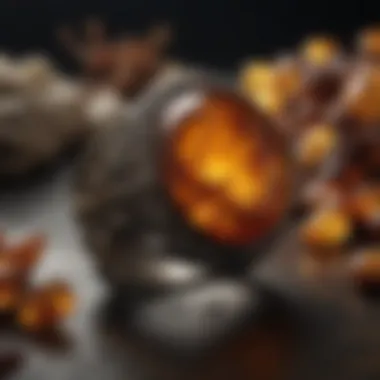
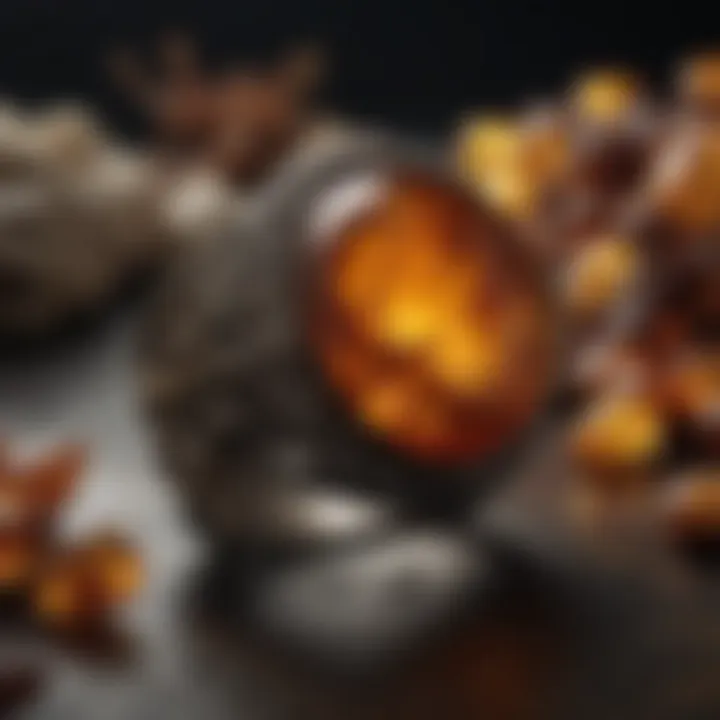
This historical narrative reinforces that amber is indeed more than just a beautiful piece of jewelry. Its journey from ancient civilizations through to modern times is a testament to its enduring allure, making Baltic amber a marvel of nature and a pillar of cultural heritage.
Contemporary Uses of Baltic Amber
The diverse applications of Baltic amber speak volumes about its importance in modern society. While once primarily valued for its aesthetic appeal, amber's versatility has paved the way for a plethora of uses that intersect art, health, and commerce. This segment explores the contemporary uses of Baltic amber, shedding light on its relevance in various fields and the benefits it offers to different audiences.
Jewelry Making
Jewelry crafted from Baltic amber has captivated artisans and collectors alike due to its warm tones and organic forms. Baltic amber can be fashioned into a variety of pieces, from elegant necklaces to bold statement rings. One notable feature is its lightweight nature, making it comfortable to wear without compromising on visual impact.
The allure of amber often lies in its unique inclusions; many pieces tell a story of ancient times, often containing trapped insects or plant matter. This attribute not only enhances the aesthetic quality but also provides a direct connection to the past, enchanting many jewelry enthusiasts.
When it comes to fashion trends, Baltic amber has taken the spotlight due to its eco-friendly appeal. Sustainable practices in sourcing amber and the rise of artisan jewelry makers have made this gemstone a go-to option for environmentally conscious consumers.
“Amber jewelry transcends mere adornment; it interlaces history, beauty, and sustainability.”
Alternative Medicine and Healing Practices
For quite some time, Baltic amber has been used in various alternative medicine practices, often praised for its purported healing properties. Many believe that wearing amber can help alleviate pain and discomfort, particularly during teething in infants. The natural acids released from amber, when worn against the skin, are thought to have analgesic effects.
Some practitioners endorse amber as a tool for emotional balance as well. The belief is that it helps to calm nerves and reduce stress, promoting a sense of groundedness in hectic environments. This has led to a rise in wellness products that incorporate Baltic amber, further solidifying its role in modern holistic approaches.
However, skeptics often challenge these claims, emphasizing that the scientific backing remains limited. Thus, it’s crucial for individuals to consider these practices within a broader context of health and wellness, understanding that amber is often used alongside conventional treatments.
Artistic Applications
Baltic amber's captivating qualities have not gone unnoticed in the art world. Artists and craftspeople harness its translucent beauty to create pieces that range from sculptures to intricate home décor items. The versatility of amber allows it to be manipulated in various ways, lending itself to a myriad of artistic vision.
One of the most notable aspects of amber in art is how it reflects light. Depending on the angle and thickness, the same piece can take on drastically different appearances, a characteristic that artists often exploit to add depth and dimension to their work.
Furthermore, collaborative projects that involve amber and other materials like metals or wood have emerged, showcasing the potential for cross-medium creativity. This intersection not only nurtures innovation but also allows artists to pay homage to the rich history and cultural significance of amber, anchoring contemporary works within a broader continuum of artistic tradition.
In summary, Baltic amber remains a stalwart of craftsmanship and healing. Its contemporary uses transcend mere decoration, touching on aspects of health and artistic expression, fostering a deeper connection with nature and history.
Economic Aspects of Baltic Amber
Understanding the economic significance of Baltic amber sheds light on its value beyond mere aesthetics. As a commodity deeply woven into the cultural fabric of societies, the various economic aspects underpin its continued fascination among enthusiasts and collectors. The multifaceted nature of amber contributes to its market dynamics, prompting a closer look at current trends, sourcing dilemmas, and counterfeiting challenges.
Market Trends and Valuation
The market for Baltic amber has experienced twists and turns, typical of many collectable materials. Prices of amber can fluctuate significantly based on demand, quality, and the notions of rarity and authenticity. A few elements play a crucial role in establishing its market value:
- Quality and Rarity: High-quality amber pieces, especially those containing unique inclusions, can fetch astronomical prices. Collectors are willing to pay top dollar for well-preserved pieces that display distinct characteristics.
- Cultural Significance: As Baltic amber carries historical and cultural weight, its valuation isn't merely based on physical properties. A piece with a notable provenance, such as having been part of an archaeological find, can substantially increase its worth.
- Market Demand: Trends in fashion and alternative medicine significantly impact the market. For instance, the recent upsurge in demand for natural wellness products led to a rise in sales for amber used in teething necklaces.
Additionally, the internet has democratized access to amber purchasing, with online marketplaces allowing both buyers and sellers from around the globe to connect. However, this increased accessibility can lead to potential pitfalls, as described below.
Sourcing and Ethical Concerns
Finding authentic Baltic amber poses challenges in an increasingly globalized market. Sourcing practices raise ethical flags that warrant discussion among consumers and collectors alike:
- Environmental Impact: The collection of amber can disrupt local ecosystems. It’s essential that sourcing practices are sustainable, and this is becoming a concern as awareness of environmental issues rises.
- Labor Practices: In regions where amber is mined, labor conditions can vary significantly. Ethical sourcing not only focuses on the product itself but also on the treatment of workers involved in the extraction process.
- Authenticity vs. Imitation: The lines have become blurred with the rise of synthetic amber and imitation products that attempt to mimic the look and feel of genuine Baltic amber. Investors and collectors need to be vigilant about verifying authenticity to make sound purchases.
These issues are prompting a shift towards more transparent practices, encouraging collectors to seek out verified and ethically sourced materials.
Impact of Counterfeits
The shadow cast by counterfeit products in the amber market has grown longer. With the allure of Baltic amber drawing in collectors, those with unsavory intentions can tarnish the image of genuine goods. The repercussions extend beyond financial losses to broader issues within the collector community:
- Trust Erosion: The presence of counterfeit amber can erode trust between dealers and buyers. When a collector realizes they’ve been sold a fake, it creates a ripple effect that impacts their future purchasing behavior.
- Market Saturation: A flood of imitation products can lead to pricing inconsistencies. Genuine pieces may lose their perceived value as buying decisions become clouded by uncertainty.
- Legal Complications: Issues surrounding the sale of counterfeit products can lead to legal battles and challenges in establishing clear provenance.
To combat the impact of counterfeits, reputable sellers and platforms are beginning to implement stricter measures such as independent testing and certification of authenticity.
Caring for Baltic Amber
Caring for Baltic amber is not just about maintaining its shine and beauty; it also serves to preserve the story that each piece tells. Given its remarkable history and cultural significance, understanding how to care for amber should be paramount for collectors, jewelers, and enthusiasts alike. Proper care ensures that the amber remains a treasured item for generations to come, safeguarding its aesthetic appeal and potential value.
Cleaning and Maintenance Techniques
Just like maintaining a classic car or a fine wine, cleaning Baltic amber has its own nuances. Amber is a delicate substance, and the methods chosen can greatly influence its longevity. Here are key techniques you might consider when it comes to cleaning:
- Gentle Wiping: A soft, lint-free cloth should be your go-to tool for regular cleaning. Just a light rub can help remove dust and oils without causing scratching or dullness.
- Lukewarm Water and Mild Soap: If the amber is particularly dirty, a mild soap solution with lukewarm water may be effective. Ensure the water isn’t too hot, as extreme temperatures can damage the resin.
- Avoid Chemicals: Stay away from harsh chemicals and ultrasonic cleaners. Such products can dull or even ruin the amber's rich surface.
- Be Mindful of Jewelry Settings: For amber set in jewelry, ensure that you do not immerse the piece in water completely, especially if it has settings made from other metals or materials that can tarnish.
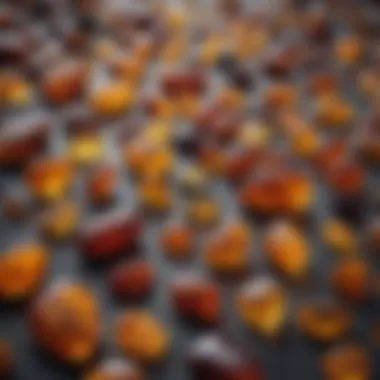

Proper maintenance requires a bit of mindfulness. Remember to handle your amber gently, as it can be scratched by harder substances. Regular inspections can help catch issues like cracks before they worsen.
Storage Recommendations
The way you store your Baltic amber can be just as important as how you clean it. Here are some guidelines that can help keep your amber in prime condition:
- Cool, Dry Place: Store amber away from direct sunlight to prevent fading. A cool and dry environment prevents moisture buildup, which can be detrimental.
- Separate Storage: Amber should ideally be stored separately from other gemstones and jewelry. This can help avoid unnecessary scratches or damage.
- Use Soft Pouches: Consider wrapping your amber pieces in soft cloths or pouches when storing them. This simple step can cushion them against impacts.
- Avoid Extreme Temperatures: Be cautious about storage locations. Avoid areas like attics or basements where temperature fluctuations can occur.
"Like a good book, Baltic amber carries the tales of yesteryears. Care for it, and the stories will remain vibrant."
In essence, caring for Baltic amber isn't merely a chore; it's a preservation of history and beauty. Following these cleaning and storage recommendations can contribute significantly to the longevity of your cherished pieces. This way, whether it’s an antique necklace or a modern pendant, they can continue to enchant future generations.
Myths and Misconceptions About Amber
Amber has earned its place in the spotlight, both as a beautiful gemstone and a historical artifact. However, nestled among its glimmering appeal are a number of myths and misconceptions that often mislead enthusiasts and collectors. Recognizing these misunderstandings is essential, not only for appreciating amber's true nature but also for preserving its cultural significance and economic value. This section will shed light on prevailing misconceptions about amber to enrich the discourse surrounding this ancient resin.
Common Misunderstandings
One of the most pervasive misunderstandings is that all amber is the same. In reality, there exists a wide variety of amber types, with Baltic amber (also known as succinite) taking center stage due to its age and quality. This amber is approximately 44 million years old, vastly superior to its younger counterparts found in other regions. Collectors commonly confuse them, which may result in undervaluation of genuine Baltic amber.
Another misconception is that amber is merely a fossilized tree sap. While it is true that amber originated from the resin of trees, its transformation is a complex blend of geological processes. The process of polymerization, where the chemical structure of the resin changes over time, contributes to its hardness and durability, making amber far more than just sap from ancient trees.
Moreover, many people believe that amber can only be found in shades of yellow or orange. In fact, amber showcases a rainbow of hues, including green, blue, and even red. The variations depend on factors like the presence of inclusions, the type of tree from which the resin originated, and the conditions under which it was fossilized.
- Amber is not just one type; it's diverse.
- It is more than tree sap—it's a geologically transformed material.
- Its colors vary widely, contradicting common beliefs.
Debunking Historical Myths
Historically, amber was thought to possess mystical properties, often considered a talisman against negative energies. Many ancient cultures attributed supernatural powers to amber, believing it could bring good luck or health. While these beliefs are culturally significant, they have often overshadowed the scientific properties of amber, leading to a skewed perception of its value.
For instance, ancient Greeks referred to amber as "electron," from which the term electricity derives. They believed that the static charge produced when amber was rubbed could attract lightweight objects. This is fascinating but often gets simplified to a mere curiosity rather than being celebrated as an early form of scientific discovery.
Another myth suggests that amber is solely a product of forested areas. As a matter of fact, the formation of amber requires specific environmental conditions, notably the presence of certain tree species, shoreline conditions, and even the climate. Geologists have identified amber deposits in regions far removed from current forests, leading to significant misunderstandings about its origin.
In summary, while amber has been steeped in myths and traditions, recognizing its true nature enhances not only our appreciation for this remarkable resin but also informs ethical practices in collection and use.
Future of Baltic Amber Discoveries
The quest to understand Baltic amber is ongoing, not merely a nostalgic journey into the past but a forward-looking exploration filled with potential. As researchers delve deeper into the mysteries of this amber, they unveil new details about its formation and applications that could reshape its significance in various fields. In this section, we will explore two critical aspects: technological advances in amber studies and the potential for new applications, both of which are vital for the future of this ancient resin.
Technological Advances in Amber Study
Thanks to continual advancements in technology, our understanding of Baltic amber has improved significantly. One of the most exciting developments is the use of paleogenomics, which allows scientists to analyze genetic material preserved within inclusions. This means researchers can study organisms that were trapped in amber millions of years ago, yielding insights into prehistoric ecosystems. Instruments such as micro-CT scanning give 3D views of amber samples without damaging them, offering a non-invasive peek into its internal structures.
Moreover, imaging techniques like Raman spectroscopy and Fourier-transform infrared spectroscopy provide detailed information about amber's chemical makeup. These methods reveal not just the overall composition but also trace compounds that could indicate the environmental conditions surrounding its formation. With each technological leap, the lifespan of discoveries around Baltic amber extends, opening up fresh avenues for both scientific inquiry and practical use.
"The fusion of technology and paleontology breathes new life into the study of Baltic amber, providing clarity where there was once ambiguity."
Potential for New Applications
Beyond just being a visual marvel, Baltic amber holds promise for a variety of applications, particularly in health and wellness. Its historical use in folk medicine may pave the way for modern research into its therapeutic benefits. Some preliminary studies suggest that the oils extracted from amber possess anti-inflammatory properties, which could be harnessed in skincare formulations or organic remedies.
Furthermore, as industries strive toward more sustainable practices, amber may find a renewed relevance. For instance, its biodegradable nature makes it an attractive candidate for eco-friendly products. The shift towards sustainable luxury can open a market for amber goods, appealing to consumers who value both aesthetics and environmental responsibility.
In the artistic realm, the unique character of Baltic amber continues to inspire designers and artisans. Value-added creations—be it in jewelry or decorative arts—may emerge, incorporating amber in innovative ways that appeal to contemporary tastes while honoring its storied past.
In summary, the future trajectory of Baltic amber studies is not just a matter of academic interest; it's about marrying ancient treasures to modern technology and sensibilities. The world of Baltic amber is ripe for exploration, and the implications could resonate across scientific, economic, and cultural landscapes.
Culmination: The Enduring Allure of Baltic Amber
The conclusion of this article serves to encapsulate the myriad aspects of Baltic amber that have been explored, reaffirming its status as a fascinating natural substance with rich historical, cultural, and economic significance. Throughout the preceding sections, we delved into its geological formation, unique physical properties, and various applications, all of which contribute to its ongoing allure. The ability of amber to bridge the ancient past with modern practices is noteworthy, providing a continual source of interest for collectors, artisans, and enthusiasts alike.
In an age where natural resources are often taken for granted, Baltic amber stands out as a reminder of Earth's profound history and the intricate processes that produce such remarkable materials. Whether it’s the beauty of amber jewelry seen in artisan shops, or its purported healing properties cherished by alternative medicine practitioners, the item's multifaceted role in contemporary society cannot be overstated.
"Amber is not just a beautiful stone; it’s a piece of ancient history, carrying whispers from the past."
Recap of Key Insights
To summarize the critical insights gleaned from this exploration:
- Geological Origins: Baltic amber originates from the resin of ancient conifer trees, primarily the Pinus succinifera species, dating back approximately 40 million years.
- Physical Properties: With color variations ranging from yellow to deep brown and features such as inclusions, amber's aesthetic appeal is significant. It is lightweight yet durable, making it suitable for various forms of jewelry and artifacts.
- Cultural Significance: Across numerous civilizations, amber has held symbolic meanings, acting as a talisman or being associated with protection, healing, and fidelity.
- Economic Factors: The market for Baltic amber continues to thrive, driven by both genuine fascination and concerns over counterfeits, prompting ongoing discussions regarding ethical sourcing.
These facets not only highlight the beauty of Baltic amber but also underscore its role as an enduring artifact in human culture.
Final Thoughts on Its Role in Culture and Economy
The role of Baltic amber in culture and economy is an intriguing narrative that extends beyond mere commerce. Its historical significance can be traced through archaeological findings, revealing its presence in ancient trade routes and its desirability as a luxury item. Today, its revival in jewelry design and alternative medicine practices illustrates a resurgence of interest that intertwines with modern values of sustainability and wellness.
Moreover, the ongoing dialogue about ethical sourcing bolsters the gemstone's cultural impact. As consumers become more conscious about the origins of their purchases, the demand for ethically-sourced amber opens avenues for artisans and businesses committed to responsible practices.



